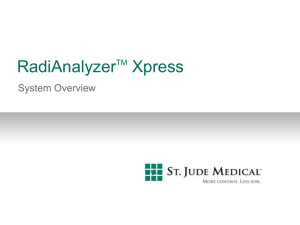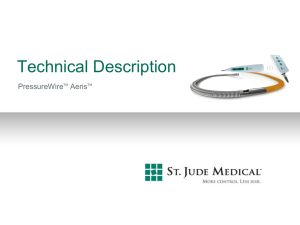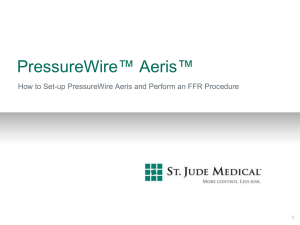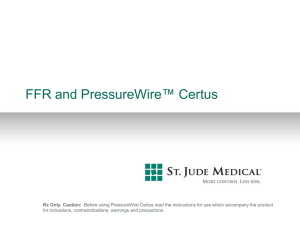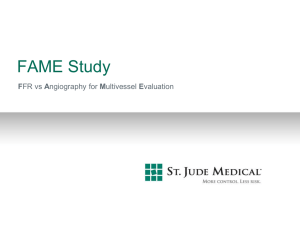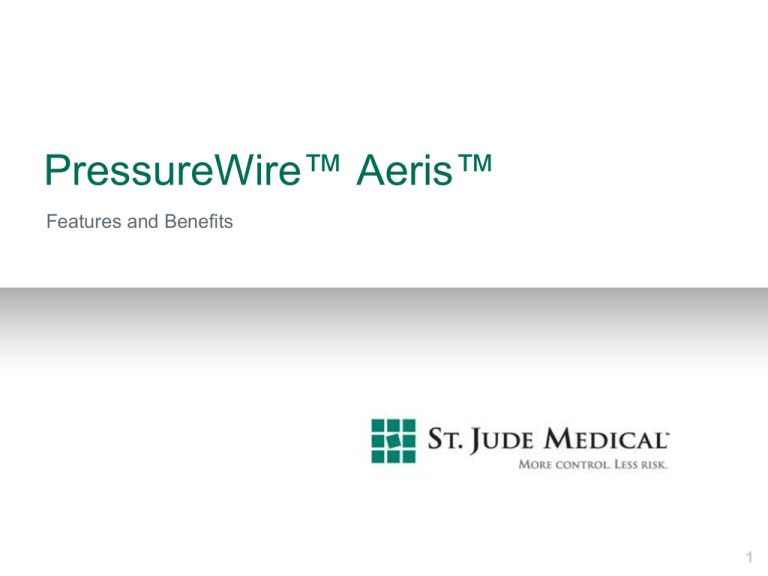
PressureWire™ Aeris™
Features and Benefits
1
Best Practice – True FFR Integration
Utilize existing equipment
Hemodynamic recording systems can be upgraded to a fully integrated, wireless measurement
system for Fractional Flow Reserve (FFR).
Instant access
Improves cath lab workflow and simplifies the FFR procedure by eliminating the need for
standalone instrumentation and time consuming setup.
No cables
PressureWire Aeris’ radio technology eliminates cables crossing the sterile field barrier, limiting
movements, which improves maneuverability of the wire.
2
PressureWire Aeris - Benefits
1. Utilize existing equipment
PressureWire Aeris and Integrated FFR
• Utilizes existing hardware installation with existing
screens, controls and front-end modules.
• All FFR results are displayed on the existing cath lab and
control room screens.
• Requires only an FFR software upgrade and one
PressureWire Receiver on the cath lab table rail. No
additional permanent cabling is required.
3
PressureWire Aeris - Benefits
2. No cables required
PressureWire Aeris and Integrated FFR
• The secure, wireless connection between PressureWire
Aeris and PressureWire Receiver eliminates cables crossing
the sterile field barrier.
• Simplifies the procedure and improves wire handling.
4
PressureWire Aeris - Benefits
3. Familiarity means easy to use
PressureWire Aeris and Integrated FFR
• All FFR calculations and display are in the same familiar recording
system environment that the staff uses for every case, every day.
• The amount of extra training required for the FFR upgrade is very
small.
5
PressureWire Aeris - Benefits
4. All results in the patient archive
PressureWire Aeris and Integrated FFR
All FFR results and hemodynamic information are stored in the existing
hemodynamic archive, with all other data including angiographic images,
for a complete patient record.
6
PressureWire Aeris
5. True FFR Integration reduces complexity
PressureWire Aeris and Integrated FFR
With all FFR calculation performed in the hemodynamic recording
system, there is no need to connect and balance AO and ECG
signals with another system.
7
PressureWire Aeris
6. Use any IVUS system
PressureWire Aeris and Integrated FFR
• This FFR solution can be installed in any cath lab with a
hemodynamic recording system that is FFR compatible,
regardless of which IVUS system the cath lab has or
may invest in in the future.
• The FFR upgrade may be installed in cath labs with existing
Volcano s5iTM Imaging System.
8
PressureWire Aeris Overview
Hydrophilic 0.014” (0.36 mm) pressure guidewire with a pressure transducer 3 cm
from the tip and a detachable battery-operated transmitter.
Wireless, secure radio connection with PressureWire™ Receiver.
Used for FFR measurement. There is no need to exchange PressureWire for a
guidewire for placement of stents and balloons.
Available in 175 cm and 300 cm (US only).
Both guidewire and transmitter are single use and are disposed of using standard
cath lab protocol for contaminated material.
Hydrophilic coated 0.014” pressure guidewire
Detachable PressureWire Transmitter
PressureWire Receiver
9
PressureWire Transmitter
Battery-operated, disposable (contaminated material)
Communicates via radio with PressureWire Aeris
Automatically zeroes pressure when turned on
Do not turn off the transmitter while inside the body, as this would
require removal from the body and re-zeroing
Normal battery operating time: 3 hours
Turn cap counter-clockwise 90° to remove guidewire
Transmitter
10
PressureWire Transmitter - Light Indicators
Light Indicator
11
Cause
Green steady light
Transmitter on
Green pulsating light
Normal operation
Pulsation proportional to blood pressure
Yellow steady light
PressureWire disconnected from
transmitter. Re-insert PressureWire firmly
into transmitter
Green pulsating light &
yellow slow blinking
light
Battery level low:
• Finish procedure or exchange
PressureWire Aeris
Yellow fast blinking
light
Error: Possible cause
• Calibration error
• Battery level too low for operation
• Internal error
Attempt restart by removing PressureWire
from body and turn the transmitter off and
on again
No light
• Not turned on
• Battery dead
PressureWire Receiver
Radio receiver for pressure from PressureWire Aeris.
Connects directly to a free pressure port in the hemodynamic recording system.
PressureWire Receiver is mounted permanently on the horizontal cath lab table rail or
on a vertical instrument pole.
Pressure and FFR measurement is displayed on existing screens of recording system in
control room and in cath lab.
PressureWire Receiver is powered by the recording system front end and requires no
extra connection or battery.
PressureWire Receiver
Recording system front end
PressureWire Aeris
P2
P1
AO-transducer
12
Hemodynamic recording system
PressureWire Receiver
“Plus” button
• Increase pressure offset by +1 mmHg or
increase reference level output in Refout mode
“Connect” button
• Press once to connect to PressureWire Aeris
• Press and hold >3 s to enter Refout mode
• In Refout mode, press once to exit
“Minus” button
• Decrease pressure offset by -1 mmHg or
decrease reference level output in Refout mode
13
PressureWire Receiver - Light Indicators
Light Indicators
+
-
14
+
-
Cause
Yellow
steady light
At startup: Unit power on and self test passed
During measurement: Wire disconnected from
transmitter or lost connection to PressureWire
Aeris
Green
blinking light
Connect mode – searching for connection
to PressureWire Aeris
Green
steady light
Established connection to PressureWire
Aeris receiving pressure
Incremental
green lights
Reference pressure level output (Refout).
• Press plus/minus to change level: 0-2040-100-200 mmHg
Plus or minus
indicators
steady blue
Positive or negative pressure offset added
to PressureWire Aeris pressure
Green steady
light & yellow
blinking light
PressureWire Aeris battery level low
• Finish procedure or exchange
PressureWire Aeris
Yellow
blinking light
Internal error
• Attempt restart by disconnecting then
reconnecting PressureWire Receiver from
cath lab recording system
Radio Technology
PressureWire Aeris utilizes advanced radio technology to ensure a stable and secure
communication and avoid disturbing other systems.
1.
2.
3.
4.
5.
PressureWire Transmitter and PressureWire Receiver lock to each other
at calibration using a unique identification code.
PressureWire Receiver stores the last connected PressureWire Aeris in its
memory.
In the event of power failure PressureWire Receiver resumes
communication.
Uses “Frequency Hopping Spread Spectrum” technology (FHSS), to avoid
interference with or disturbance from other systems in the cath lab.
Transmits using very low radio power.
PressureWire Transmitter
.
.
.
400 hops/s
15
PressureWire
Receiver
79 channels
Rx Only
Please review the Instructions for Use prior to using these devices for a complete listing of
indications, contraindications, warnings, precautions, potential adverse events and
directions for use.
Product referenced is approved for CE Mark.
PressureWire is designed, developed and manufactured by St. Jude Medical Systems AB.
PressureWire Aeris, RADI, ST. JUDE MEDICAL, the nine-squares symbol and MORE
CONTROL. LESS RISK. are registered and unregistered trademarks and service marks of
St. Jude Medical, Inc. and its related companies. ©2011 St. Jude Medical, Inc. All rights
reserved
Volcano s5i™ Imaging System is a trademark of Volcano Corporation.


